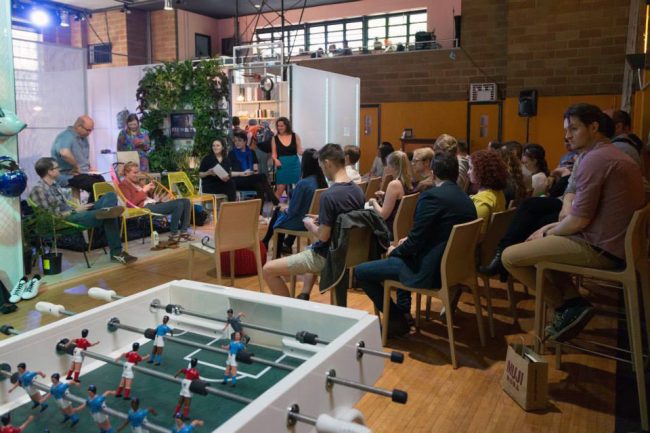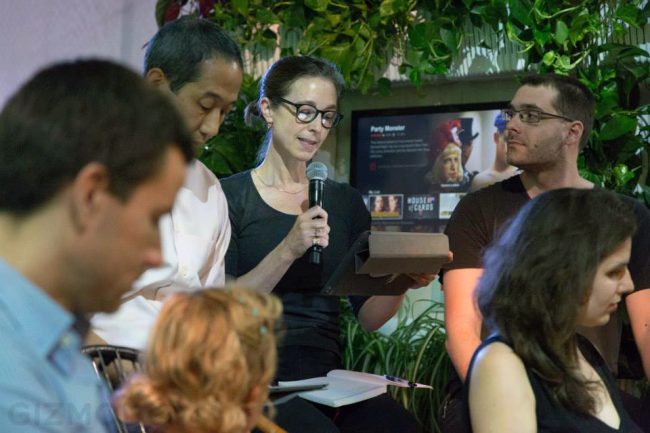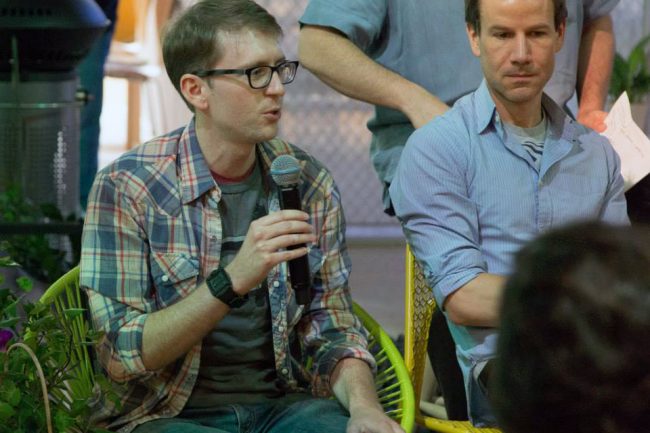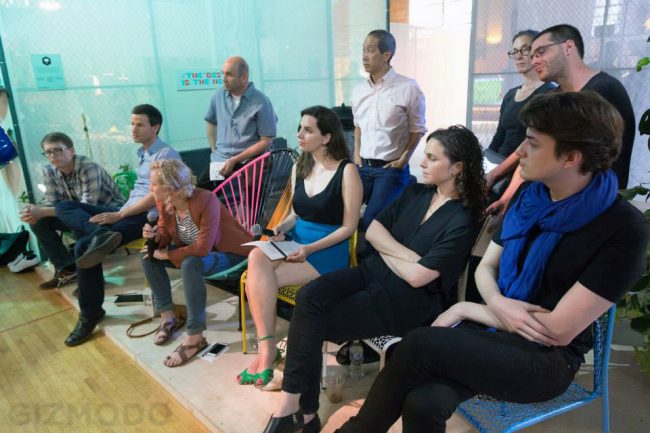
We are celebrating 15 years — and counting — of stories that are deeply researched and deeply felt, that build a historical record of what the city has been.
We are celebrating 15 years — and counting — of stories that are deeply researched and deeply felt, that build a historical record of what the city has been.

In Gizmodo’s House of the Future | Photo by Nicholas Stango, courtesy of Gizmodo
At Gizmodo’s Streets of the Future debate last month, Robin Nagle, NYC Department of Sanitation’s resident anthropologist, read a passage from Italo Calvino’s Invisible Cities about a fantastical city whose residents projected all their “most elevated virtues and sentiments” onto a duplicate — but superior — city in the sky, and all their “base and unworthy” castoffs onto a duplicate — but inferior — city underground. Nagle was one of ten architects, academics, journalists, and urban thinkers asked to weigh in on the future of the street in one of the panels put on in conjunction with Gizmodo’s Home of the Future exhibition, an immersive, one week-installation displaying what an urban home and related technologies and gadgets might look like in the future. And each of the panelists intricately — if contentiously — projected their delights and frustrations with today’s streetscape onto their imagined cities of tomorrow.
Like the high-tech gadgets stocked in the Home of the Future behind them, several speakers dwelled on how technology might change how our streets are built and occupied in the future. Curbed editor Amy Schellenbaum pointed to the successful Kickstarter fundraising campaign for +POOL as a way that technology can democratize the often expensive and politically tangled process of public space creation. Schellenbaum and Nagle suggested that some existing technologies, if deployed more extensively, could greatly streamline some wasteful urban metabolic systems. Heat energy could be harvested from the subway. Waste collection by pneumatic tube, already in use at Disney World and on Roosevelt Island, is being deployed on a mass scale in some Scandinavian cities.

Robin Nagle | Photo by Nicholas Stango, courtesy of Gizmodo
But, as in any good science fiction novel, the role of technology as solely a force for good was challenged. Several speakers imagined a streetscape under constant surveillance. Architect Andy Bernheimer, who designed the Home of the Future installation, lamented that gadgets have “begun to destroy our periphery, deadening our interactions at the personal level.” We take pictures of an event instead of actually watching the event, and frequently sacrifice our basic safety for the sake of whatever is grabbing our attention on our phones. Bernheimer recommends a “closed, disconnected urban fence” that deadens cell signals on the sidewalk, with accessible hotspots located every ten blocks.
The vision of architect Jeffrey Inaba also focusses on people and public space. Inaba thinks that, in the future, streets will be “rare.” In their place, we’ll have open spaces of various kinds. Innovations in transportation, today so fractured and inefficient, will free up more outdoor space for more appealing uses of our time. The passenger vehicle is mostly to blame. Inaba says cars are in use for only 5% of their lifetimes, and during rush hour in San Francisco, 72% of cars are parked. He reminds us that during Carmageddon in Los Angeles in 2011, government- and media-induced anxiety over the closure of the nation’s busiest interstate reached such fever pitch that the region’s highways were left largely empty that weekend. The skies were clearer than they had been in decades, and Angelenos stayed home socializing with neighbors or walked to local restaurants and businesses. Now LA planners want a car-free weekend every month.
Not everyone is so anti-car however. Matt Hardigree, editor of car blog Jalopnik, ventured that the streets of tomorrow will look like the streets of today (to some boos from the audience). Hardigree derided the idea that everything’s going to change, that we’ll “put down our phones and hug each other.” He conceded that total dependence on our cars is detrimental to society in some pretty big ways. The dominance of the solo-driver commute has been tied to elevated stress, frayed family relationships, and, of course, pollution, injury, and death. But Hardigree wants to see a car culture take the place of our commuter culture. The amount of time and money being poured into technologies and infrastructures that support self-driving cars proves Hardigree might not be too off-base. But Jeffrey Inaba pointed out that Audi was so concerned about the absence of cars in architecture students’ renderings that it sponsored a future streets study at Columbia’s Graduate School of Architecture, Planning & Preservation.

Matt Hardigree | Photo by Nicholas Stango, courtesy of Gizmodo
Geoff Manaugh, organizer of the panels for Gizmodo and founder of BLDGBLOG, envisages a future street not for cars or people, but for plants, animals, and robots. Already, he says, street dogs in Moscow have learned how to get around on the Metro, and after the 2008 housing crisis, mountain lions took over entire subdivisions in southern California. He points to the rodent-deterring mint-flavored trash bag as a light design touch that considers a non-human user of the city. And in deference to a wheeled robot that was scurrying around the Home of the Future, Manaugh pointed out that an unforeseen side effect of the Americans with Disabilities Act (which mandates ramps in public buildings) is that our cities are more robot-friendly.
But how will we get there? Amy Schellenbaum wagers that it will take a massive catastrophe to change the way we think about our streets. New York City certainly learned a lot about security in the aftermath of 9/11 and about rising waters in the wake of Superstorm Sandy. But Karen Kubey of the Institute for Public Architecture doesn’t think catastrophes are enough to shift the paradigm; people just want to get back to normal. More than likely, change will come from years of smart people — like those assembled here — talking about, writing about, and, block by block, building the street of tomorrow.

Streets of the Future panelists | Photo by Nicholas Stango, courtesy of Gizmodo
The views expressed here are those of the authors only and do not reflect the position of The Architectural League of New York.